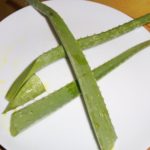Aloe Vera Revisited
Sometimes things become so strongly associated with a single, well-known use that we forget that they may have other useful applications. Such is the case with Aloe Vera. Most people are aware of its benefits for burns. That is why it is a common houseplant kept in the kitchen to deal with the damage caused by hot oil splatters and inadvertent contact with hot cookware or scalding liquids. It is also a favorite, and effective, remedy for sunburn.
As we take a closer look at the plant, there are certain important distinctions to be made. The part of the plant that we use is the inner gel of the leaf. This is the healing part. The outer, green leaf portion exudes a mildly caustic, yellow sap that has a pronounced laxative effect and can easily be taken to toxic levels. When you read about cautions for Aloe, it is for the “whole plant” preparation that allows the laxative sap from the green leaf surface to be included in the mixture with the gel. You can easily see this sap for yourself when you take a slice of fresh Aloe vera; look closely at the deep green edges of the cut and you can observe the secretion of liquid beads of yellow. This is why you need to “filet” your leaf and be sure to use only the inner gel for skin care or juicing.
The active compounds in Aloe vera have been identified as primarily glycoproteins and polysaccharides. These compounds are found in many medicinal plants, (i.e. Echinacea, Astragalus) that enhance immune function, reduce inflammation and promote cellular healing. Aloe vera is a rich and concentrated source of these compounds, which explains, in part, its skin healing properties. It has also been found to contain all of the vitamins, except Vitamin D, as well as vital minerals and trace elements. So, it is a nutritional powerhouse; a healing food.
Emerging research is now supporting the use of Aloe vera for a wide variety of internal health concerns.
UCSD Moore’s Cancer Center has conducted research that confirms that taking a dose of 2-4 ounces of Aloe vera juice has an anti-tumor effect, as its compounds bind with abnormal cells and cause them to dismantle themselves before they can become malignant. At Jefferson Medical College the conducted human trials that showed Aloe vera to be effective against HPV (Human Papilloma Virus) that is considered the instigator of many cervical cancers. The British Journal of General Practice offers evidence to support the use of Aloe vera juice to treat as wide a variety of complaints as acid reflux, nausea, stomach ulcers, arthritic joint pain and even high blood glucose in diabetics. Not to mention, any condition with inflammation.
All of this research is finally validating the traditional, folkloric and cultural uses of Aloe as a “blood cleanser” and a liver “detoxifier.” It has been shown that either topical applications or internal consumption will neutralize toxic elements in the skin, body tissues or in the blood and bind to facilitate removal. This is beneficial to body pH, liver function and bowel health.
Next time you are at the supplements section of the store and see a bottle of Aloe vera juice, you will now understand more of its potential benefits for your own health. As with most plant products, fresh and alive is better than pasteurized and preserved. It is not that difficult to make your own Aloe vera gel/juice: pick a leaf, slice off the green parts, apply directly or put in the blender with other juices. However, be advised that you need to have the correct plant. There are many garden varieties of decorative Aloe plants and some of those varieties have much higher levels of caustic saps in their skins, making them more difficult to handle. Make sure that you have a plant known as Aloe VERA, and not some other version. And if you are taking Aloe vera for some health concern, it is advisable to also discuss that condition you’re your healthcare provider to track your progress. When you take Aloe vera, be ready to be soothed, in every possible way.
Category: Health & Fitness








